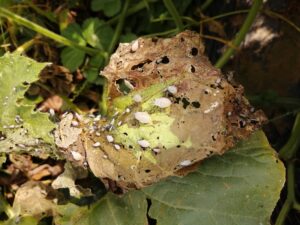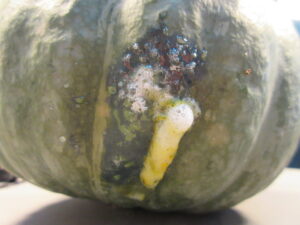For a few years, I participated in the Squash Hunger Trial led by Dr. Annette Wszelaki, where we grew a wide range of winter squashes at multiple states. One year, I failed to manage insects, leading to a squash bug and cucumber beetle outbreak. The insects defoliated leaves (Figure 1) and caused cosmetic damage to the fruit. We managed to harvest some good-looking fruit and hoped to store them for up to 6 months as indicated on the seed package. Surprisingly, we started to see oozing from several of these fruits in a few weeks (Figure 2). I could not figure it out until I saw a related discussion among several vegetable specialists at the Great Lakes Vegetable Working Group.

Figure 1. Squash bug damage on winter squash leaves.

Figure 2. Oozing on a winter squash fruit at storage.
This phenomenon is not unique to one region. According to Ben Phillips, the vegetable crops educator at Michigan State University, the correlation between squash bugs and the post-harvest froth appears strong. Ben explained that the foam indicates pathogenic respiration taking advantage of the pin-prick wound caused by insects. Poor storage conditions, such as a facility without good air exchange, bins filled too deeply, or high humidity may support the proliferation of the pathogen. Brian Hudelson, plant disease diagnostician from the University of Wisconsin-Madison, further explained that an opportunistic yeast Getotrichum might be associated with the symptoms. It is possible the yeast gains entry into the fruit through insect wounding. While it digests tissues, it produces a fair amount of carbon dioxide, creating symptoms like oozing from the fruit. I learned from other specialists the symptoms are commonly observed on acorn squash, spaghetti squash, even summer squash, and it could happen in the field or in storage.
To help the problem, Ben suggested to reduce squash bug population (I assume other insect causing similar damage as well); keep vines healthy to make squash bugs interested in more things than just the fruit; pick without delay to limit squash bug feeding; and sell immediately to limit the effects of poor storage conditions.